For over 2,000 years, the Chinese have been using the iridescent blue feathers of kingfisher birds as an inlay for fine art objects and adornment, from hairpins, headdresses and fans to even panels and screens. While Western art collectors have focused on other areas of Chinese art including porcelain, lacquer ware, sculpture, cloisonné, silk and paintings, kingfisher art is relatively unknown outside of China.
Called 'tian-tsui' (點翠) - "dotting with kingfishers", kingfisher feathers are painstakingly cut and glued onto gilt silver. The effect is like cloisonné, but no enamel was able to rival the electric blue color. Blue is the traditional favorite color in China.
As with most iridescent, electrifying colors in animals such as morpho butterfly wings, the intense color in bird feathers comes not from pigments in the feather itself, but from the way light is bent and reflected back out, much like a prism breaks white light into its spectrum of rainbow colors. These microscopic structures in feathers are called photonic crystals.
The most expensive, commissioned pieces used a species of kingfisher from Cambodia. So great was the export to sate Chinese demand, the trade of feathers may have been a major contributor to the wealth of the Khmer Empire, which used to help fund the construction of the magnificent temples near Siem Reap, Cambodia including Angkor Wat. The finest pieces of kingfisher art were reserved for royalty or high-ranking Chinese government official. Sadly, the usage of kingfisher feathers resulted in the mass slaughter of many kingfisher species.
However, kingfisher art as a high art form came to an end during the Chinese revolution in the 1940s.
Pictures below are the magnificent antique Chinese kingfisher feather hair adornments, with plant, peach, butterfly, fu dog, crane and phoenix design, and the coil gilt metal base. The hair ornaments themselves could be functional or decorative, serving to either help hold the hair in place in the case of the very large hair slide known as 'bianfang', which essentially supported the two side buns and was often decorated on one side with a large hanging tassel which swung as the wearer walked, or in the case of smaller pins and ornaments be displayed entirely for their beauty and workmanship.
The variety of materials used along with the kingfisher feathers included gold or silver (depending on wealth and rank), pearls, precious and semi-precious stones notably unfaceted rubies and sapphires, tourmalines and carnelians, the highly-valued Peking glass, coral, jade or jadeite, mother of pearl and sometimes in the case of dangling hair ornaments (liusu) brass figures such as fish. The ornaments themselves came in a huge variety of shapes including birds, animals, insects, flowers and other plant life including fruit and gourds, children or small figures, auspicious symbols including the 'shou' (long life) and 'shuangxi' (double happiness) symbols, shapes such as the Eight Buddhist Emblems and even in the case of larger crowns and tiaras, small still life scenes depicting court life or famous scenes. However, the most popular themes were butterflies, bats, dragonflies, grasshoppers, fish and gourds. The reason for these choices was several-fold, for apart from their intrinsic charm and beauty, these motifs held another type of significance. The Chinese language is rich with homophones, words that sound like one another but have different meanings, with the result that saying one thing can evoke something entirely different, sometimes humorous or for the superstitious Chinese, auspicious. Well-known examples of this include happiness (fu) and bat (bianfu), prosperity (yu) and fish (yu), or interesting combinations such as butterfly and gourd (guadie nian nian) creating a rebus meaning offspring for eternity. Other motifs had their own inherent meanings, such as peaches and pomegranates (fertility), paired ducks (marital happiness), cranes (immortality) and lingzhi mushrooms (longevity). Because of this, there resulted a strong visual vocabulary, almost a type of visual shorthand so that the use of certain animals, insects or symbols would result in a piece that was not only able to be admired for its exquisite workmanship, but also had great meaning for the wearer and all those around her and usually connoted her wish for a happy and fulfilled life, preferably with many sons.
It can be understood in the light of this that the Chinese of this era wore jewellery for different reasons to us today, usually more for aesthetic reasons or the enjoyment of the wearer, or as a practical means of storing their assets, rather than actually showing off wealth. In addition, the choice of background metal was again stipulated by formal decree, and gold was generally only permitted for ornaments for the ladies of the Imperial Court or the very wealthy. Whatever the metal it was wrought into an astonishing variety of shapes, often three-dimensional and was frequently worked as filigree; quite frequently design elements such as stems, branches and leaves were fashioned with a springy copper ball so that they trembled when the wearer moved or walked, adding to the charm and beauty of the final picture.
One of the earliest cultures to begin making jewellery in Asia were the Chinese around 5,000 years ago. Chinese jewellery designs were very religion-oriented and contained Buddhist symbols, a tradition which continues to this day. The Chinese used silver in their jewellery more often than gold and decorated it with their favourite colour, blue. Blue kingfisher feathers were tied onto early Chinese jewellery and later, blue gems and glass were incorporated into designs. However, jade was preferred over any other stone and was fashioned using diamonds. The Chinese revered jade because of the human-like qualities they assigned to it, such as its hardness, durability and beauty. The first jade pieces were very simple, but as time progressed, more complex designs evolved. Jade rings from between the 4th and 7th centuries BC show evidence of having been worked with a compound milling machine, hundreds of years before the first mention of such equipment in the West.
In China, jewellery was worn frequently by both sexes to show their nobility and wealth. However, in later years, it was used to accentuate beauty. Women wore highly detailed gold and silver head dresses and other items, while men wore decorative hat buttons, which showed rank, and gold or silver rings. Women also wore strips of gold on their foreheads, much like women in the Indus Valley. The band was an early form of tiara and was often decorated with precious gems. The most common piece of jewellery worn in China was the earring, which was worn by both men and women. Amulets were also common, often with a Chinese symbol or dragon. Dragons, Chinese symbols and phoenixes were frequently depicted on jewellery designs. The Chinese often placed their jewellery in their graves. Most Chinese graves found by archaeologists contain decorative jewellery.
Since the beginning of civilisation, humans have sought to adorn and decorate themselves, and the Chinese were no exception. Inspired by the beauty and variety of the birds and animals around them, they sought from the very earliest times to emulate these seemingly perfect creatures by first adorning themselves with their pelts and plumes, then with increasing sophistication to embellish the clothes and accessories they wore, finally establishing by the time of the Qing dynasty (1644-1911), a highly-stylised and visible social and political hierarchy based upon their perception of the intrinsic characteristics of these creatures and famously epitomised by the bird and animal rank badges of that era. Unsurprisingly perhaps, headgear and hairstyles evolved in the most spectacular manner, and the crests and head plumes of the birds the Chinese encountered provided inspiration over the centuries for an astonishing variety of hats, crowns, tiaras, hairstyles and hair ornaments.
Excavations of Tang dynasty (A.D. 618-906) tombs have revealed tiny kingfisher jewellery pieces which were probably used more in the manner of gems or decorative items, and there are descriptions of a dying king from the Han dynasty (206 B.C.-A.D. 220) detailing his private chamber in which there were kingfisher hangings on jasper hooks and bedspreads of kingfisher all seeded with pearls, apparently from the manner of their description not necessarily unusual objects for the time. No museum collection of Chinese dress is without at least one or two examples of this art. Indeed kingfisher feathers were employed with dazzling effect in a large variety of items for personal adornment including not only hair ornaments but crowns, wedding head-dresses, bracelets, nail guards, brooches, earrings, pendants and occasionally even larger objects art such as screens and tableaux.
Although it is evident that kingfisher decorative items had existed for many centuries, they were at their most spectacular when used to decorate women hair ornaments and this was an art form whose artistic culmination was reached in the Qing dynasty when the Manchus took control of Imperial power.
 The kingfisher feather hairpin with the motifs of insect and lotus, inlaid with carnelian semi precious stone and ruby.
The kingfisher feather hairpin with the motifs of insect and lotus, inlaid with carnelian semi precious stone and ruby.
Length : 11cm
 The back of the hairpin.
The back of the hairpin.
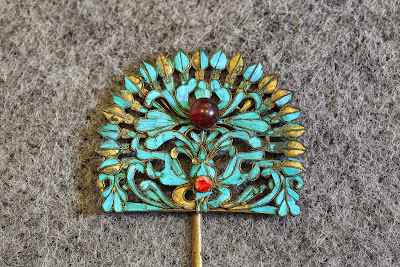 The details of the workmanship.
The details of the workmanship.
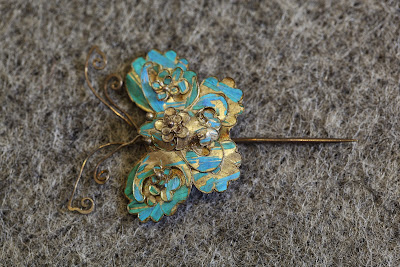 The kingfisher feather hairpin with butterfly motif.
The kingfisher feather hairpin with butterfly motif.
Length : 5.5cm
 The back of the hairpin with mark.
The back of the hairpin with mark.
 The kingfisher feather hairpin with flower motif.
The kingfisher feather hairpin with flower motif.
Length : 9.5cm
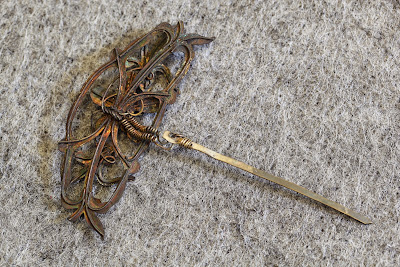 The back of the hairpin.
The back of the hairpin.
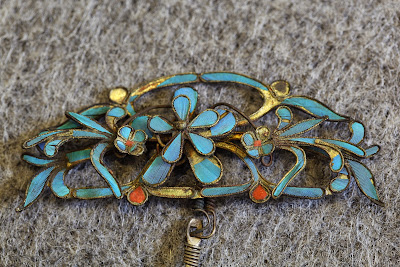 The details of the hairpin.
The details of the hairpin.
 The kingfisher feather hairpin with flower motif and coral bead.
The kingfisher feather hairpin with flower motif and coral bead.
Length : 8.5cm
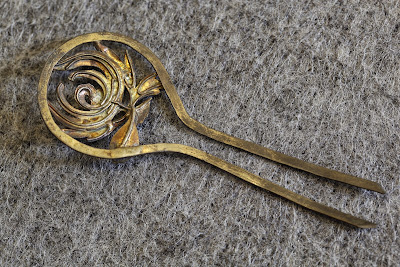 The back of the hairpin.
The back of the hairpin.
 The details of the workmanship.
The details of the workmanship.
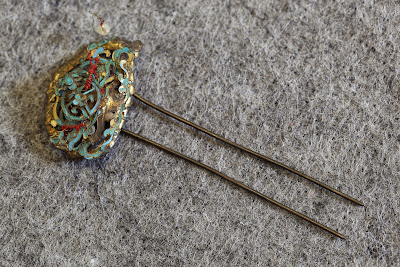 The kingfisher feather hairpin with butterfly and flower motifs.
The kingfisher feather hairpin with butterfly and flower motifs.
Length : 9.5cm
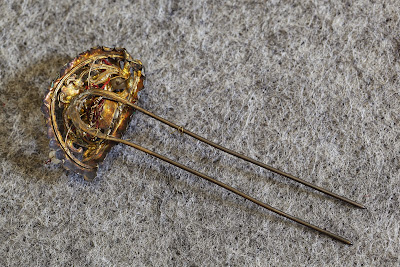 The back of the hairpin.
The back of the hairpin.
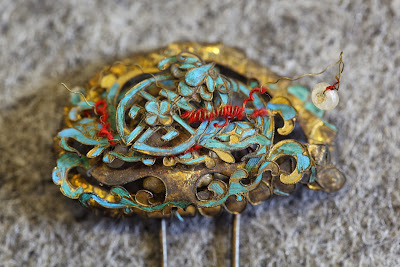 The details of the workmanship.
The details of the workmanship.
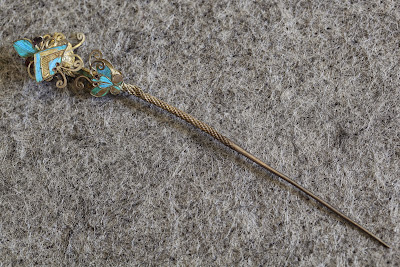 The kingfisher feather hairpin with the motifs of two butterflies.
The kingfisher feather hairpin with the motifs of two butterflies.
Length : 12.5cm
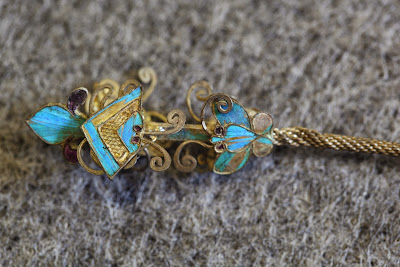 The details of the workmanship.
The details of the workmanship.
 The kingfisher feather hairpin with the motifs of a fu dog and the fireball.
The kingfisher feather hairpin with the motifs of a fu dog and the fireball.
Length : 10.5cm
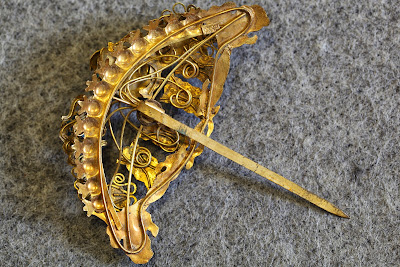 The back of the hairpin.
The back of the hairpin.
 The mark at the back of the hairpin.
The mark at the back of the hairpin.
 The details of the workmanship with rotatable fireball.
The details of the workmanship with rotatable fireball.
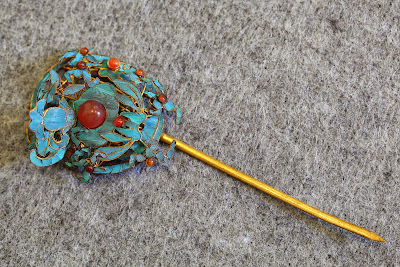 The kingfisher feather hairpin with the motifs of a bat and peach fruit, inlaid with carnelian semi precious stones.
The kingfisher feather hairpin with the motifs of a bat and peach fruit, inlaid with carnelian semi precious stones.
Length : 16.5cm
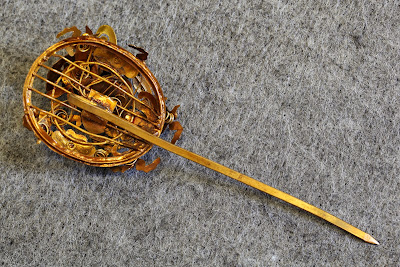 The back of the hairpin.
The back of the hairpin.
 The details of the workmanship.
The details of the workmanship.
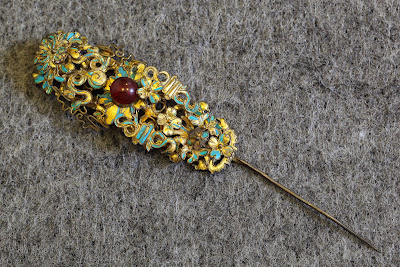 The kingfisher feather hairpin with flower motifs, inlaid with carnelian semi precious stone.
The kingfisher feather hairpin with flower motifs, inlaid with carnelian semi precious stone.
Length : 13cm
 The back of the hairpin with mark.
The back of the hairpin with mark.
 The details of the workmanship.
The details of the workmanship.
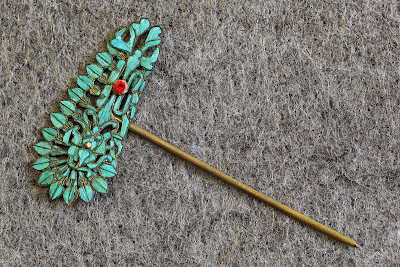 The kingfisher feather hairpin with the motifs of lotus and insect, inlaid with ruby.
The kingfisher feather hairpin with the motifs of lotus and insect, inlaid with ruby.
Length : 9cm
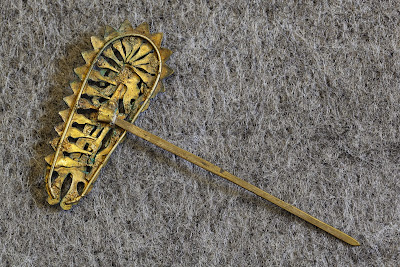 The back of the hairpin.
The back of the hairpin.
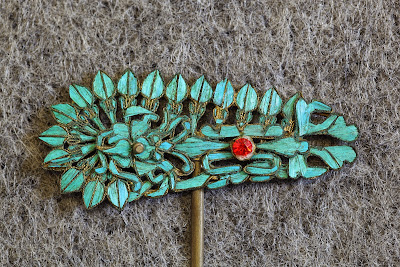 The details of the workmanship.
The details of the workmanship.
 The kingfisher feather hairpin with flower motif.
The kingfisher feather hairpin with flower motif.
Length : 5.5cm
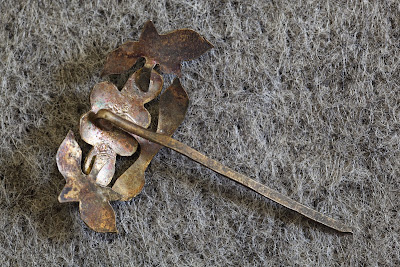 The back of the hairpin.
The back of the hairpin.
 The details of the workmanship.
The details of the workmanship.
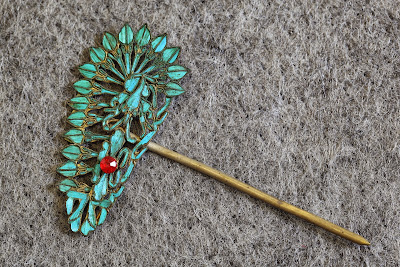 The kingfisher feather hairpin with the motifs of lotus and insect, inlaid with ruby.
The kingfisher feather hairpin with the motifs of lotus and insect, inlaid with ruby.
Length : 9cm
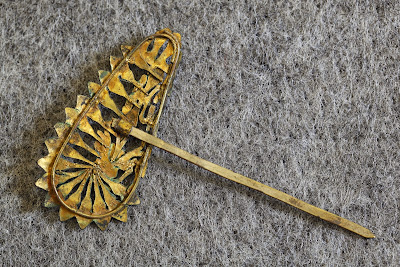 The back of the hairpin.
The back of the hairpin.
 The details of the workmanship.
The details of the workmanship.
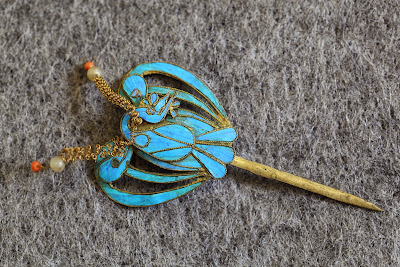 The kingfisher feather hairpin with the motif of a crane.
The kingfisher feather hairpin with the motif of a crane.
Length : 7.5cm
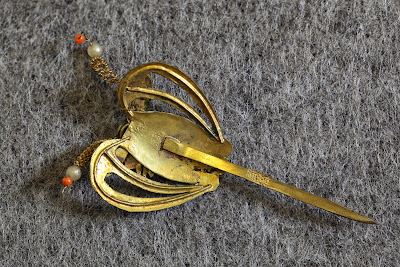 The back of the hairpin.
The back of the hairpin.
 The mark at the back of the hairpin.
The mark at the back of the hairpin.
 The details of the workmanship.
The details of the workmanship.
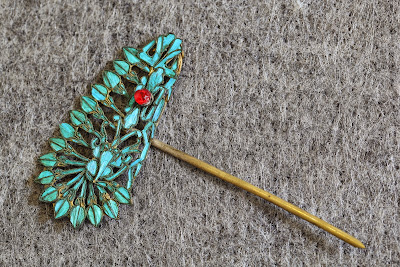 The kingfisher feather hairpin with the motifs of lotus and insect, inlaid with ruby.
The kingfisher feather hairpin with the motifs of lotus and insect, inlaid with ruby.
Length : 9cm
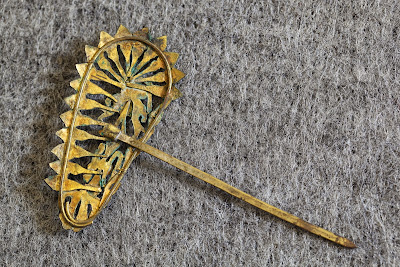 The back of the hairpin.
The back of the hairpin.
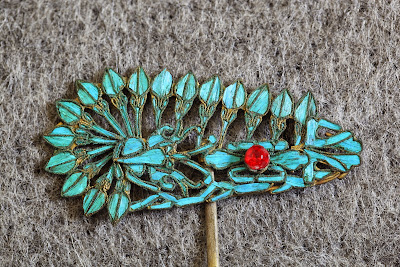 The details of the workmanship.
The details of the workmanship.
 The kingfisher feather hairpin with the motifs of lotus and insect.
The kingfisher feather hairpin with the motifs of lotus and insect.
Length : 8.5cm
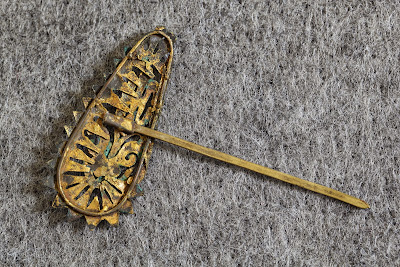 The back of the hairpin.
The back of the hairpin.
 The details of the workmanship.
The details of the workmanship.
 The kingfisher feather hairpin with the motif of flower, inlaid with ruby.
The kingfisher feather hairpin with the motif of flower, inlaid with ruby.
Length : 4cm
 The back of the hairpin.
The back of the hairpin.
 The kingfisher feather hairpin with the motifs of lotus and insect, inlaid with carnelian semi precious stone.
The kingfisher feather hairpin with the motifs of lotus and insect, inlaid with carnelian semi precious stone.
Length : 11cm
 The back of the hairpin.
The back of the hairpin.
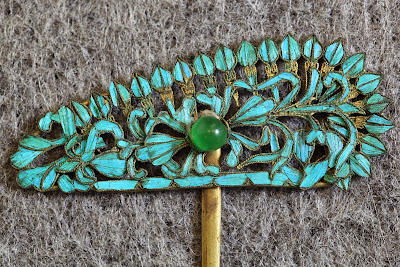 The details of the workmanship.
The details of the workmanship.
 A pair of kingfisher feather hairpins with the motifs of butterfly, flower and a pair of phoenixes.
A pair of kingfisher feather hairpins with the motifs of butterfly, flower and a pair of phoenixes.
Length : Left : 12cm, Right : 11cm
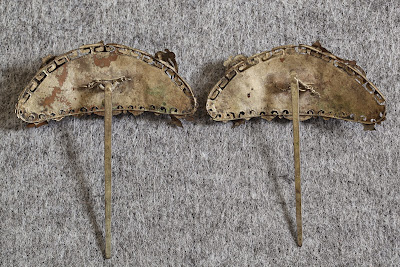 The back of the hairpins.
The back of the hairpins.
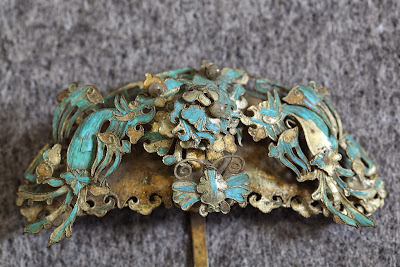 The details of the workmanship.
The details of the workmanship.
 The details of the workmanship.
The details of the workmanship.
 A phoenix motif kingfisher feather hair adornment.
A phoenix motif kingfisher feather hair adornment.
Length : 9cm
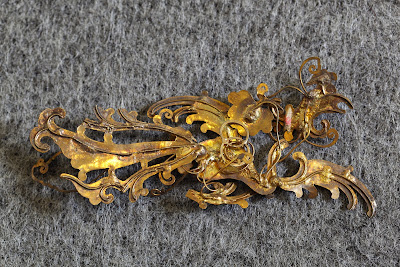 The view of the back side.
The view of the back side.
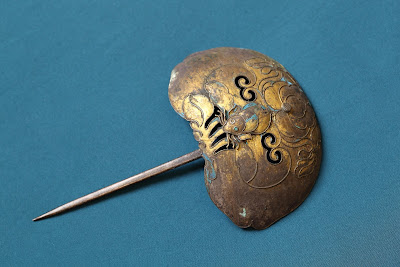 The kingfisher feather hairpin with the motifs of a bat and flower, which majority of the kingfisher feather loss on the panel.
The kingfisher feather hairpin with the motifs of a bat and flower, which majority of the kingfisher feather loss on the panel.
Length : 12.5cm
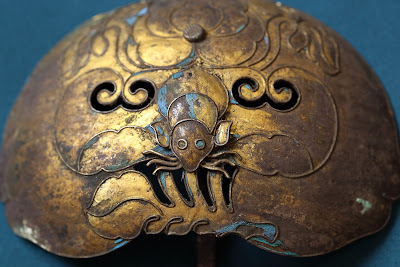 The details of the workmanship.
The details of the workmanship.
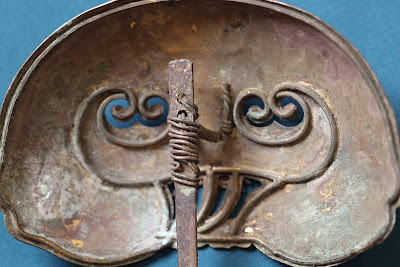 The back of the hairpin.
The back of the hairpin.
 The remains of the kingfisher feathers.
The remains of the kingfisher feathers.
 The kingfisher feather hairpin with only some of the kingfisher feathers left.
The kingfisher feather hairpin with only some of the kingfisher feathers left.
Length: 4.5cm
 The details of the workmanship.
The details of the workmanship.
 The back of the hairpin.
The back of the hairpin.
 Picture 1
Picture 1